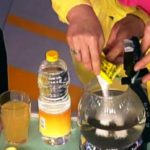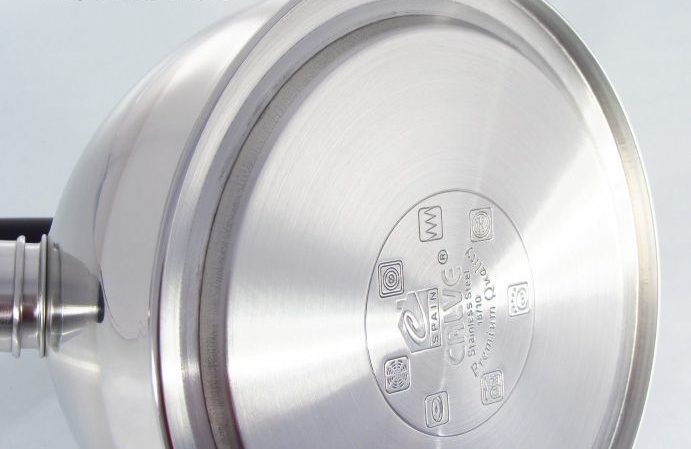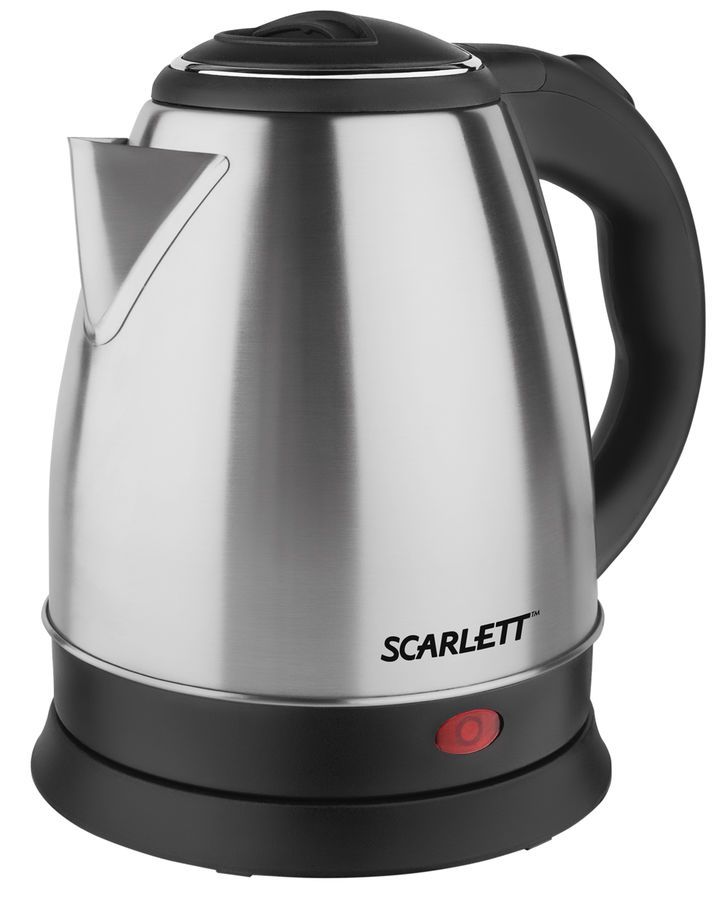How to descale a kettle with citric acid
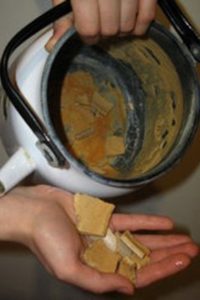 The kitchen is a place where many housewives spend quite a lot of time, every now and then scrubbing something, cooking and washing. Undoubtedly, every kitchen has a kettle that you don’t want to part with because you like it and are satisfied with it. It can be electric or simply enameled, but in any case, over time, plaque and scale accumulate inside, which must be removed. In this article we will look at how to clean plaque and scale from different kettles and keep it clean for a long time.
The kitchen is a place where many housewives spend quite a lot of time, every now and then scrubbing something, cooking and washing. Undoubtedly, every kitchen has a kettle that you don’t want to part with because you like it and are satisfied with it. It can be electric or simply enameled, but in any case, over time, plaque and scale accumulate inside, which must be removed. In this article we will look at how to clean plaque and scale from different kettles and keep it clean for a long time.
The content of the article
How to descale a kettle with citric acid
It doesn’t matter what material the product is made of, but a coating appears on its surface. This process is due to the fact that in the water that we eat there are salts, which actually form it on the walls and even on the element that is responsible for heating the water, if we are talking about an electric kettle. Especially a lot of plaque accumulates if the water is very hard. Filtered water, of course, forms less scale, but still, after some time, there will be scale from it that needs to be removed.
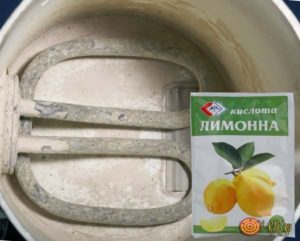 Each housewife has her own proven methods for descaling. Some use special cleaning products, others use folk advice.Let's talk a little about cleaning products; their use is not advisable. Because after cleaning, during subsequent boiling, they will be released into the water, and this will cause serious harm to health, because this is chemistry. You should not use iron brushes, scrapers, or abrasives; they greatly damage the surface and should definitely not be used after cleaning. You can boil a kettle using lemon; it’s easy, simple, and not harmful to health. But many are also interested in how many times the kettle will have to be boiled.
Each housewife has her own proven methods for descaling. Some use special cleaning products, others use folk advice.Let's talk a little about cleaning products; their use is not advisable. Because after cleaning, during subsequent boiling, they will be released into the water, and this will cause serious harm to health, because this is chemistry. You should not use iron brushes, scrapers, or abrasives; they greatly damage the surface and should definitely not be used after cleaning. You can boil a kettle using lemon; it’s easy, simple, and not harmful to health. But many are also interested in how many times the kettle will have to be boiled.
Many may ask why citric acid? Firstly, it is accessible and has a reasonable price. Secondly, it is safe and will not harm your health. There are a sufficient number of cleaning methods using citric acid.
Important! If the plaque is large, then the hot method is used. If the plaque is small, then you can use the cold method. Next, we will consider in what proportions it is used.
How to use lemon correctly
The materials for teapots come in a variety of different types, and depending on this, each type requires different care. There are teapots made of plastic that require more careful and gentle care. For such products, acid must be used extremely carefully, or you may simply ruin the product.
Glass
If you have a glass kettle in your kitchen, you can use powder and lemon slices to clean it. The best option for cleaning such a teapot is to use lemon essential oil:
- Dilute 20 drops of oil in two glasses of water;
- And then rub the inner surface.
Then wait a few minutes and wash off the scale with a sponge.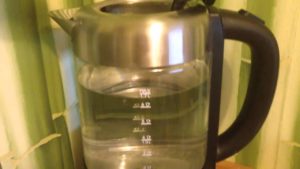
Metal
If you need to clean a stainless steel product in the kitchen, you can use citric acid.If the product is aluminum, then acid cannot be used, because when heated, the metal tends to dissolve a little. If the kettle is made of stainless steel, then it is cleaned like this:
- Boil water;
- Put a slice of lemon there or add lemon powder and leave to cool;
- Afterwards, wash it with a sponge, and then boil it for the first time and pour it out. Then you can safely use it.
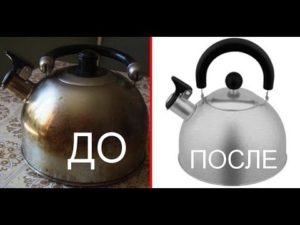
Plastic
Most electric kettles are made of plastic and, of course, you should never use vinegar, but you can use citric acid. If the plaque is small, then you don’t even need to boil it, it will be enough:
- Boil a kettle, add 1-2 tablespoons of acid;
- Cool the water;
- Drain the cooled water.
And please continue to use it. Only the first time you will need to boil the water and pour it out. You can wash the kettle this way several times.
Electric
For this type of product, an excellent option would be lemon powder or pieces of lemon.
- You need to throw acid or a slice of lemon into boiling water and let it boil for a few minutes.
- Then cool the water and pour it out.
- All bad odors and scale will be washed off with water.
The next cleansing method is as follows:
- You need to leave the lemon juice solution for the whole night.
- Then pour out the water in the morning and wash the kettle.
This method can be used if the plaque is small.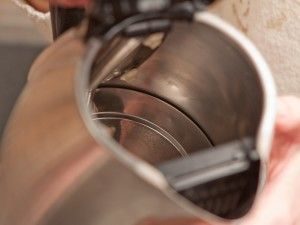
Enameled
An enameled product can be cleaned in almost the same way as a metal teapot. You just need to take into account that the enamel can crack due to temperature changes, so this should not be allowed. That is why, after boiling, you should never immediately rinse it with ice water.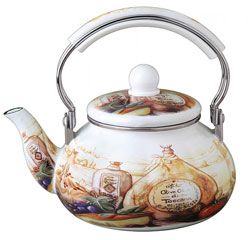
How to Peel Using a Plain Lemon
When there are small children in the house, housewives always try to use the safest cleaning methods and hypoallergenic products. Of course, every mother will wonder whether citric acid will harm the child? But to protect yourself and your child, you can prepare citric acid yourself. Of course, you won’t need to prepare any powder, everything is much simpler:
- You need to take the simplest lemon, cut it into slices;
- Fill 2/3 with water, add chopped lemon and boil;
- The scale deposit will become soft and can be cleaned using a sponge, then wash the product with water.
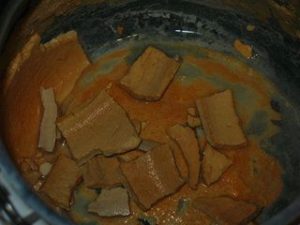 Citric acid is an excellent option for descaling a kettle. A completely acceptable and simple cleaning option. In addition, the method is completely harmless and fast, and the teapot will retain a pleasant lemon smell for some time. As for the powder itself, it is added depending on how dirty the kettle is.
Citric acid is an excellent option for descaling a kettle. A completely acceptable and simple cleaning option. In addition, the method is completely harmless and fast, and the teapot will retain a pleasant lemon smell for some time. As for the powder itself, it is added depending on how dirty the kettle is.
To keep the product clean all the time, it is enough to use lemon at least once a week and you can completely forget about scale. If the kettle is electric, then it is better to use lemon acid of natural origin. If there is a large layer of scale, you will need to cut 2-3 lemons.
Important! Lemon juice can be used frequently for descaling. Moreover, this will seriously extend its period of operation, preserving the performance and health of the whole family. After all, if there is scale, it can get into the water, and, accordingly, into the human body. No scale - no problems with the kidneys and liver, no infections.
Scale prevention
There are simple and very useful rules for caring for a kettle, they are easy to follow:
- To prevent scale from forming on the heating element and the walls of the kettle, it is recommended to use purified water. You can buy it in stores or install a filter on your faucet at home. Today there is a huge selection of different filters and their prices are very different. If it is not possible to install a filter or buy water, then you can take it as a rule and let the water settle before boiling it. And only after that pour it into the kettle.
- You cannot boil the same water several times. Firstly, such water becomes “dead” and not useful, so it is best to replace it with a new one each time.
- Before pouring water, you need to rinse the kettle. There should be no white flakes in the water.
- After use, you can leave the kettle overnight without water and wipe it dry from the inside, then less scale will form and the kettle will last longer.
- Clean the kettle with a lemon regularly, this will also prevent the appearance of large amounts of scale.
- Although this product is used everywhere, getting it on the skin and mucous membranes is not advisable, because it can irritate and even burn them. Also, citric acid powder should not be inhaled, because it can negatively affect the respiratory tract.
- Constantly cleaning the kettle is a simpler and less labor-intensive process than removing large amounts of scale from the surface.
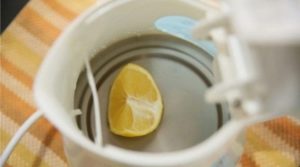 It is necessary to descale dishes in a timely manner, until the layer is very large. By observing and knowing some secrets of cleanliness, you can easily maintain it in your home.
It is necessary to descale dishes in a timely manner, until the layer is very large. By observing and knowing some secrets of cleanliness, you can easily maintain it in your home.
Useful tips
Every housewife wants to keep things clean for a long time, and here are some useful notes that will help maintain cleanliness and prolong the life of the product:
- If there is no acid or it has run out, then it is quite possible to replace it with lemon. It is possible to squeeze the juice out of it, but you can simply cut it into slices or circles and then use it for cleaning.
- If there is neither lemon nor acid, then you can use baking soda, especially if you need to clean an iron kettle.
- If you decide to mix acid and baking soda, but there are none, then don’t be upset. Then you can take baking powder for the dough, since it contains both soda and acid.
- If there are no powders, then you can take lemonade. It is simply poured into a teapot and left for 2-3 hours. In this case, the lid must be open for the gas to escape. Afterwards, you need to boil the lemonade and then rinse the product. The result will be wonderful. But it’s better to choose transparent drinks, or you can paint the surface of the kettle an unattractive color.
- If you have dishes made of heat-resistant glass, you should wipe them with a slice of lemon once a month. If there is no lemon, then you can dilute citric acid and also wipe the surface. Then the dishes will be clean.
- To remove dark stains on a metal surface, you can use the following means: mix lemon juice and pharmaceutical alcohol in equal parts, and then use a cotton pad to apply the solution to the stained surface. After 30 minutes, the dishes can be washed; if you are not satisfied with the result, you can repeat all the steps again.
Here are some fairly simple and cheap ways to maintain the frequency of teapots, and from different materials. By following tips and recommendations, you can not only keep the product clean, but also extend its service life. Of course, it is better to use such simple and natural remedies that are safe for health.


